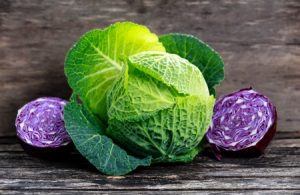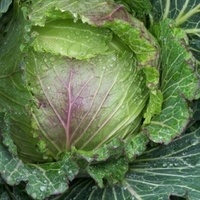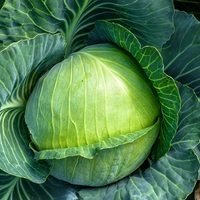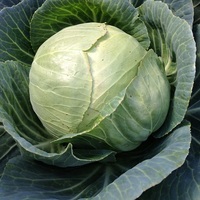Introduction To Growing Cabbages
Cabbages literally are the kings of the vegetable patch and have formed the basis of green fare for the Sunday lunch since time immemorial. Lewis Carroll’s immortal words from the poem, “The Walrus and the Carpenter” which appeared in Alice Through the Looking Glass have reflected on the humble cabbage being a little more regal. They are also much more varied than many gardeners think and along with other members of the family like broccoli, kale, collard greens and pak choi really have plenty to offer. All cabbages are full of antioxidants and vitamin C.

It looks as if they are gaining popularity and probably because we are becoming more adept at using it with our enlightened culinary skills. Gone are those days when you were confronted with soggy, smelly and overcooked piles of leaves. Nowadays, we are boiling and steaming them much more gently. They are an ideal accompaniment to roasted meats, can be shredded into salads and coleslaws, stir-fried, steamed and fermented to make sauerkraut. Soup is a good one and I love them in colcannon and ‘bubble and speak’. It is nutritionally rich providing us with antioxidants, vitamin C and K, iron and potassium.
Sowing
Cabbages need to be treated with more care than imagined. Leafy cabbages have a high nitrogen requirement so I follow my harvested legumes when doing my crop rotation. Also, always keep the growing seedlings well watered!
(1) Undercover Sowing
For best results, seed is planted individually into compost filled plastic cells and undercover such as a cold frame or unheated greenhouse. Begin sowing from mid-February to early March. A 0.5cm to 1cm (½in.) covering of compost should suffice.
Do a further transplant undercover when the seedlings are large enough if they were sown in trays. They are spaced about 5cm apart in an undercover bed or in individual pots of compost to develop the roots and leaves. Young plants are then transplanted outdoors in April but not until they have been hardened off beforehand. The final month for sowing is June (undercover and outdoors).
(2) Outdoor Sowing
Prepare the nursery bed for sowing the seeds by creating a fine tilth and then watering. Make these sowings outside in April which is usually later than an undercover sowing, into the prepared bed where the seeds are sown thinly in rows 15cm (6in.) apart. Sow them at a depth of 1.5cm (approx. 1in.) and in about 14 to 21 days we see seedling growth. Keep them well-watered until the plants have established.
They are then thinned out to 7.5cm (3in.) apart when the seedlings have become large enough to handle. Further spacing is required which we explain about in the next section ‘Growing On’.
Whilst cabbages need a bit more thought than we might have expected, with good planning and range of growing techniques at our disposal, we can have crop all year round.
Growing On
Cabbages prefer a well-drained and fertile soil which wont dry out, and with a neutral to alkaline pH (6.5 to 7.5). Acidic soil is not tolerated so garden lime needs to be added until the soil pH reaches 6.5. An alkaline soil protects against clubroot which is a disease that attacks brassicas including swedes generally and lives in acidic soils.
One week before planting out, a general fertiliser is added into the soil. The young cabbage plants are transplanted to their final growing positions when they are 10cm (4in.) tall and have about 5 or 6 leaves.
We often transplant seedlings at a distance of 45cm-50cm apart. The growing distance however depends on the size of the variety grown. The maximum gap is 60cm apart which is ideal for a savoy cabbage such as ‘January King‘. A variety like ‘Golden Acre’ can be grown at a spacing of 40cm with rows just 30cm apart. In general though, allow 60cm between the rows if unsure.
To pick an earlier harvest and of course smaller cabbages, the young plants can be spaced at 35cm (14in.) apart whilst larger cabbages are planted 50cm (20in.) apart.
Looking After Young Plants
Cabbages need to be watered regularly, the rows kept weed free and ideally mulched to retain moisture in the soil and keep the weeds at bay. Lack of watering causes bolting. Plants need to be protected from a range of pests and they should be fed with a commercial nitrogen feed or for the organically minded, a home-made nettle tea feed.
Harvesting
Summer cabbages are harvested in late June to October. Once the hearts have firmed up, dig out the whole plant or cut through the stem at the base. A cross can be carved onto the head of the remaining stump to generate further leaves. Early varieties like ‘Greyhound’ are enjoyed between June and September. The winter harvested varieties such as ‘January King‘ are picked between November and March.
Plants For All Year Round
To vary the types of cabbages in terms of their size try the following:-
Thin our spring cabbages for your early ‘greens’ before they begin hearting. Fleece part of the crop to bring forward your harvest by roughly two weeks. If you plant small cultivars quite densely you can get smaller but larger crops. Varieties like Minicole produce what are called ‘mini-heads’ that are ideal for the lunch table.
Some Dutch white and a few red cabbages will store for 6 to 8 weeks in a cool spot.
Winter cabbage can withstand bolting for weeks if the site is sheltered.
Make crossing cuts across the stump of harvested plants. This produces a second flush of regrowth to use as ‘greens’ !
Pests And Issues With Cabbages
– Cabbage White Butterfly Caterpillars
The cabbage white butterfly might be an insect of beauty but the bain of cabbage growers. They lay their eggs on the underside of the leaves and the caterpillars quickly massacre a plant. The best protection is to lay a mesh such as Veggiemesh™ or Enviromesh™ over the cabbage. Otherwise, regularly inspect the plant for caterpillars and remove, take off the eggs or spray with a pyrethrum based insecticide.
– Cabbage Root Fly
The female cabbage root fly looks like a housefly and lays its eggs in soil around the stem of the cabbage plant. The white larvae gorge on the plant roots which causes wilting. The best solution is to fit a collar around the stem to prevent eggs being laid.
-Whitefly
Whitefly are small, moth-like insects that have proved be immensely troublesome to cabbage. They produce sticky deposits that encourage sooty mould growth that damages leaves. Insect mesh, yellow sticky traps or a spray with a pyrethrum based insecticide will suffice to control it.
– Clubroot
A major issue for any brassica grown in acidic soils. It is a soil-borne fungal disease that causes cabbage leaves to wilt with a purple discolouration. The roots especially are affected as they swell and become deformed. The best treatment is to raise the pH of the soil to neutral or alkaline using garden lime worked into the substructure and given time to take effect.
– Pigeons
What a nuisance ! They eat every part of the leaf to leave a skeleton. Best to use protective mesh or encourage a large cat.
Cabbage Varieties
cv. Golden Acre/Primo II – ideal for poor soils and produces a firm, compact, medium sized round head which is ideal for smaller vegetable plots. Usually harvested from July onwards. Has a good flavour whether cooked or in salads. Excellent level of vitamin C. Enjoy this cabbage between July and October.
Greyhound – good sized early cabbage with an unusual pointed head and best for the larger vegetable plot. Enjoy this cabbage between June and September.
Hispi F1 – a pointed variety for growing in small spaces with good bolt resistance. One with a sweeter flavour than most. Crops into late summer and autumn.
 January King – purchase your seeds for cv. January King here. Cabbage January King is a medium sized cabbage that is round and green in colour. This cabbage can be sown in late spring to then be harvested in the winter months of November and December.
January King – purchase your seeds for cv. January King here. Cabbage January King is a medium sized cabbage that is round and green in colour. This cabbage can be sown in late spring to then be harvested in the winter months of November and December.
Jersey Wakefield – the heritage variety with a uniform shape and conical-shaped heads. The hearts are pale green and is ideal for small plots too. Harvested from late July onwards.
 Mozart – purchase your seeds of cv. Mozart here. A versatile variety with exceptional standing ability. Its strong root system means improved tolerance of drought, and resistance to pest attack. Use for producing a good quality bulbous head.
Mozart – purchase your seeds of cv. Mozart here. A versatile variety with exceptional standing ability. Its strong root system means improved tolerance of drought, and resistance to pest attack. Use for producing a good quality bulbous head.
Red Jewel F1 – a red cabbage producing ruby red leaves with crisp, tightly packed hearts. Picked from late July through to October.
 cv. Stonehead .Cabbage Stonehead is a good quality round winter cabbage. Cabbage Stonehead Sowing Guidelines – When to Sow Seeds: May – Jul Temperature Required: 12°C + Cover Seed: Lightly Time to Germinate: 4 – 5 months.
cv. Stonehead .Cabbage Stonehead is a good quality round winter cabbage. Cabbage Stonehead Sowing Guidelines – When to Sow Seeds: May – Jul Temperature Required: 12°C + Cover Seed: Lightly Time to Germinate: 4 – 5 months.
cv. Storka – Simply Seeds offer this variety. The cultivar is a good white ballhead cabbage used for producing 1 – 3kg head sizes. Suitable for all plot sizes as it can be grown at a low density per metre for larger heads, but is also ideal for planting closer together for smaller sized heads of around 1kg. Typically matures after 130 days, so good for October / November Picking from a May sowing.
Storka has a strong tolerance to bolting and is a shiny green exterior colour with an attractive pale internal colour. Stores well when kept cool.
The variety cv. Tundra is often rated as the best cabbage to overwinter by both commercial and amateur growers, giving very good results. Sow seeds from may to early July.
Savoy Types
cv. ‘January King 3’ – a popular winter cabbage which is hardy and reliable. Heads are firm, purple-tinged and full of excellent flavour as well as antioxidants and vitamin C. Purchase seeds from Johnsons, Suttons Seeds, Mr Fothergills.
Timings For Award Of Garden Merit cabbage cultivars
The RHS in the UK issues an AGM for any plant which meets a certain rigorous standard. Here we describe those varieties which can be planted out to cover various times of the year.
Sow crops in seed trays and plant out (transplant) seedlings as indicated:-
- Spring: Spring Hero or Pyramid are sown late summer for transplanting in autumn.
- Early Summer: Derby Day (early ball head) or Shelta are sown in early spring and transplanted in late spring.
- Summer/Autumn: Stonehead is sown in spring or early autumn. Transplant spring and summer.
- Red cabbage: Red Jewel is sown in early spring and transplanted in late spring or early summer and harvested then in summer and autumn.
- Winter: Dutch white cabbage such as Tundra, purple January King types (January King 3) and crinkly savoys such as Noelle are sown in late spring or early summer and then transplanted in summer.
Please note we are affiliate marketing partner. Please read our affiliate disclosure.
Purchase your cabbage seeds here
Leave a Reply